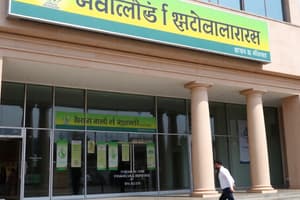Podcast
Questions and Answers
What was one of the primary objectives of the study?
What was one of the primary objectives of the study?
- To assess financial literacy among individual investors (correct)
- To determine the best investment strategies
- To study the impact of taxation on investments
- To analyze the performance of investment portfolios
What is the current state of financial literacy in India, particularly in rural areas?
What is the current state of financial literacy in India, particularly in rural areas?
- Financial literacy is poor, especially in rural areas. (correct)
- Financial literacy is at a satisfactory level in rural areas.
- Financial literacy is significantly improving in urban areas.
- Financial literacy is high across all regions.
Which method of measurement was used for evaluating the responses in the study?
Which method of measurement was used for evaluating the responses in the study?
- Standard deviation
- Qualitative analysis
- Arithmetic mean
- Weighted Likert scale (correct)
What were the weights assigned to the response options in the Likert scale?
What were the weights assigned to the response options in the Likert scale?
What initiative has been introduced to improve financial literacy in India?
What initiative has been introduced to improve financial literacy in India?
Which organization emphasizes the components of financial literacy?
Which organization emphasizes the components of financial literacy?
What limitation was noted concerning the data collection?
What limitation was noted concerning the data collection?
What hypothesis was proposed about financial literacy and personal financial planning?
What hypothesis was proposed about financial literacy and personal financial planning?
What did the study indicate about the awareness level of Indian individuals regarding financial investments?
What did the study indicate about the awareness level of Indian individuals regarding financial investments?
What approach is suggested for improving financial literacy in India according to the literature reviewed?
What approach is suggested for improving financial literacy in India according to the literature reviewed?
What type of data was primarily used for the study?
What type of data was primarily used for the study?
According to Dr. K.C. Chakrabarty's report, what is the main focus of financial literacy education?
According to Dr. K.C. Chakrabarty's report, what is the main focus of financial literacy education?
What was a potential issue noted regarding respondent honesty?
What was a potential issue noted regarding respondent honesty?
What method is primarily used to collect data in this study?
What method is primarily used to collect data in this study?
What demographic is highlighted as having high saving rates in India?
What demographic is highlighted as having high saving rates in India?
What type of data is primarily used in the research methodology?
What type of data is primarily used in the research methodology?
What aspect did the study highlight about the sample of respondents?
What aspect did the study highlight about the sample of respondents?
What is a significant challenge facing financial literacy initiatives in India?
What is a significant challenge facing financial literacy initiatives in India?
Which factor is NOT mentioned as influencing financial literacy in the study?
Which factor is NOT mentioned as influencing financial literacy in the study?
How many questions does the survey consist of?
How many questions does the survey consist of?
What scale is used for respondents to assess their level of knowledge in the survey?
What scale is used for respondents to assess their level of knowledge in the survey?
What types of questions are included in the study's questionnaire?
What types of questions are included in the study's questionnaire?
Who is the target population for this study?
Who is the target population for this study?
What research design approach is employed in this study?
What research design approach is employed in this study?
What percentage of respondents have income that falls short of their expenses?
What percentage of respondents have income that falls short of their expenses?
Which method is least commonly used by respondents to overcome income shortfalls?
Which method is least commonly used by respondents to overcome income shortfalls?
What is the primary objective behind the investments made by respondents?
What is the primary objective behind the investments made by respondents?
What is the first preference for saving money according to the respondents?
What is the first preference for saving money according to the respondents?
What percentage of respondents save money in light of future uncertainties?
What percentage of respondents save money in light of future uncertainties?
What percentage of respondents were able to cover their living expenses without borrowing money?
What percentage of respondents were able to cover their living expenses without borrowing money?
Which of the following represents the second preference for saving among respondents?
Which of the following represents the second preference for saving among respondents?
What is the second most common way respondents overcome income shortfalls?
What is the second most common way respondents overcome income shortfalls?
What is the most common source of advice respondents utilize for their financial decisions?
What is the most common source of advice respondents utilize for their financial decisions?
Which banking facility is primarily used by the majority of respondents?
Which banking facility is primarily used by the majority of respondents?
What investment product are the most respondents aware of?
What investment product are the most respondents aware of?
How many respondents have not planned for their expenses after retirement?
How many respondents have not planned for their expenses after retirement?
What percentage of respondents considers their affordability before making a purchase?
What percentage of respondents considers their affordability before making a purchase?
What percentage of individuals closely monitor their financial affairs?
What percentage of individuals closely monitor their financial affairs?
Which investment option is listed as having the least number of respondents investing in it?
Which investment option is listed as having the least number of respondents investing in it?
Which demographic group is primarily aware of Fixed Deposits and other financial products?
Which demographic group is primarily aware of Fixed Deposits and other financial products?
Flashcards are hidden until you start studying
Study Notes
Financial Literacy in India
- Awareness of financial literacy is growing in Indian universities and schools, emphasizing its importance for future generations.
- Indians exhibit high savings rates but have moderate awareness regarding investments in financial markets.
- Rural areas in India show significantly low financial literacy, leading to potential investment issues.
Significance of Financial Literacy
- Financial literacy encompasses awareness, skills, and behaviors necessary for sound financial decision-making.
- The Reserve Bank of India's 'Project Financial Literacy' highlights the poor financial literacy status in India.
Research Overview
- A study was conducted to assess the level of financial literacy among individual investors and its impact on personal financial planning.
- The study utilized primary data collected through questionnaires, targeting literate individuals with income sources.
Objectives and Hypotheses of the Research
- The objective was to measure financial literacy levels and understand its influence on personal financial planning.
- The study hypothesized that there is no significant relationship between financial literacy and personal financial planning among individual investors.
Methodology
- Primary data was collected via structured questionnaires, which included various financial literacy-related topics.
- The questionnaire employed a 4-point Likert scale for responses, measuring agreement levels from 'Agree' to 'Strongly Disagree'.
Findings on Financial Behavior
- A significant portion (71.4%) of respondents experienced situations where income fell short of expenses.
- Most respondents (93.9%) indicated they save money, showing awareness of future uncertainties.
- Planning for retirement expenses was evident among 63.3% of respondents, indicating some level of foresight in financial planning.
Investment Preferences and Awareness
- Fixed Deposits, Insurance, and Mutual Funds emerged as popular investment choices among respondents.
- A high level of awareness was noted regarding financial products like Fixed Deposits and Insurance, particularly in the 30-50 age group.
Financial Decision-Making
- A notable percentage (71.4%) of individuals carefully consider affordability before making purchases.
- Approximately 49% of respondents actively monitor their financial affairs, demonstrating varying levels of engagement with personal finance.
Studying That Suits You
Use AI to generate personalized quizzes and flashcards to suit your learning preferences.




